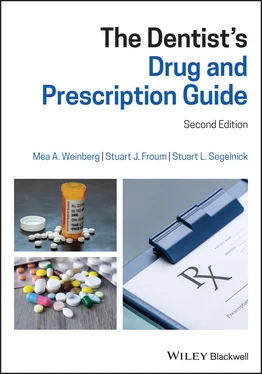3.2.4.2 Azithromycin Tablets ( Table 3.13)
Dose required: 10 mg/kg/day q24h × 3 days.
How supplied: 250 mg, 500 mg, 600 mg tablets.
3.2.5 Clindamycin
3.2.5.1 Clindamycin Oral Solution ( Table 3.14)
Dosage required: 10–30 mg/kg/day q6–8 h.
How supplied: oral solution 75 mg/5 mL (100 mL bottle).
3.2.5.2 Clindamycin Capsules ( Table 3.15)
Dosage required: 10–30 mg/kg/day q6–8 h.
How supplied: 75, 150, 300 mg capsules.
Table 3.15 Calculating the dose of clindamycin capsules in mg for a 10‐year‐old child weighing 70 lb
| Step 1 Convert pounds to kg: |
70 lb × 1 kg/2.2 lb = 31.8 kg |
| Step 2 Calculate the dose in mg: |
31.8 kg × 10 mg/kg/day = 318 mg/day |
| Step 3 Divide the dose by the frequency: |
318 mg/day ÷ 4 (qid) = 80 mg/dose q6h |
The dose is 80 mg; either 75 mg capsules can be prescribed and increase the number of days of therapy, or it may be best to use the oral suspension.
3.3 Pregnant and Nursing Patients
1 Q. Why may dosage adjustment be required in the pregnant patient?
2 A. Pregnancy and the first weeks of life represent two physiological situations in which there are continuous and significant changes in the levels of plasma proteins, and it may therefore be necessary to adjust the doses of medication during these times (Moore 1998).
3 Q. Why is it important to be aware of the effect of drugs in the nursing mother?
4 A. Nearly all drugs pass into human milk by passive diffusion. Almost all medication appears in very small amounts, usually less than 1% of the maternal dose. The higher the dosage, the more the drug transfers into milk. Different features of drugs including molecular weight, fat solubility, and half‐life will affect how much of the drug is transferred into the milk. The pH of milk is 7, which is slightly lower than plasma (pH 7.4) so that drugs that are weak bases (e.g., erythromycins, tetracyclines) will achieve high concentrations in breast milk and should be avoided.
5 Q. What are the “new” FDA pregnancy categories?
6 A. Approximately 30 years ago, the FDA required that all prescription drugs absorbed systemically or known to be potentially harmful to the fetus be given a pregnancy category of A, B, C, D or X. Table 3.16lists all categories (Lynch et al. 1991). In 2014, the FDA replaced the letter categories with new labeling that is more explanatory to patients and clinicians and enables more effective patient counseling. This classification was revised in 2015. The new Pregnancy and Lactation Labeling Final Rule (PLLR) started on June 30, 2015 and can be found on the package insert of the medication. The PLLR consists of narrative sections and subsections which include the following ( www.drugs.com/pregnancy‐categories.html). Table 3.16 FDA pregnancy categoriesDrug categoryDescriptionAControlled studies in women fail to show a risk to the fetusBAnimal or human studies have not shown a significant risk to the fetus. No controlled studies in pregnant women. Drugs have been found to have adverse effects in animals but no well‐controlled studies of humansCDrugs for which there are no adequate studies, either animal or humans, or drugs shown to have adverse fetal effects in animals but for which no human data are availableDFetal risk in humans is evidentXStudies in animals or humans have shown definitive fetal risk. These drugs are contraindicated in women who are or may become pregnant
Pregnancy (includes labor and delivery)
Pregnancy Exposure Registry
Risk Summary
Clinical Considerations
Data
Lactation (includes nursing mothers)
Risk Summary
Clinical Considerations
Data
Females and males of reproductive potential
Pregnancy Testing
Contraception
Infertility
1 Q. What drugs used in dentistry are safe during pregnancy and breast feeding?
2 A. The “new” pregnancy label is not without debate (Walker 2018). Since we cannot print all the statements of the drugs dentists use, the original letter categories will be used. See Table 3.17(Turner et al. 2006). Table 3.17 List of dental drugs commonly used during pregnancy and nursingSource: Adapted from New York State Department of Health (2006). Oral Health Care during Pregnancy and Early Childhood. Practice Guidelines. Moore (1998). www.drugs.com/pregnancyDrugFDA categoryCan use during pregnancy?Can use during nursing?AntibioticsAmoxicillinBYesYesPenicillin VKBYesYesErythromycin base or ethylsuccinateBYes (except for estolate form)YesClarithromycinCNoNo data available. Manufacturer cautions against its use in nursing mothersAzithromycinBYes; no human studies; give when benefits outweigh riskNot enough information. Manufacturer advises cautionCiprofloxacinCNoDiscontinue breast feeding or do not use ciprofloxacinClindamycinBYes; when benefit outweighs riskExcreted in mother's milk. Discontinue nursing or choose another antibioticMetronidazoleBYes but not in first trimesterDiscontinue breast feeding for 12–24 hours. Best to prescribe another antibioticTetracyclinesDNoNoAnalgesicsAcetaminophenBYesYesAspirinC/D (risk for use during third trimester)No. Aspirin use in pregnancy has been associated with alterations in both maternal and fetal hemostasisNoIbuprofen (and all NSAIDs including Naprosyn® and naproxen)B/D (D in third trimester; do not recommend during third trimester)After first trimester for 24–72 hours only. Best to avoid in third trimester due to effects on fetal cardiovascular system (closure of ductus arteriosus)No data available. Effects on nursing baby are not knownCodeine (e.g., acetaminophen with codeine)C/D (in third trimester)Only give if benefit outweighs risks. Codeine is the only narcotic analgesic which has shown a statistically significant association with teratogenicity (involving respiratory tract malformations; depression)Codeine is metabolized to morphine, which can result in morphine overdose in the baby, especially if mothers are ultra‐rapid metabolizers of codeine. Signs of morphine overdose in a nursing baby include limpness, increased sleepiness, and difficulty breathingHydrocodone (e.g., Vicodin®)C/D (in third trimester)Neonatal respiratory depressionHydrocodone is metabolized to codeine isomer and a small percent to hydromorphone. Signs of morphine overdose in a nursing baby include limpness, increased sleepiness, and difficulty breathingAntifungal agentsNystatinBYesYesClotrimazole (topical)BYesYesLocal anestheticsLidocaineBYesYesMepivacaineCNoCautionBupivacaineCNoYesEtidocaineBYesYesPrilocaineBYesYesArticaineCNoCautionMarcaineCNoCautionAnesthesiaNitrous oxideNot classifiedNot in first trimester; with caution in third trimesterControversial; consult with patient's prenatal care providerAntianxiety drugsBenzodiazepines (e.g., diazepam, alprazolam)DNoNoTriazolam and temazepamXNoNo
3 Q. Why are there concerns about the use of antibiotics during pregnancy?
4 A. Some antibiotics have adverse effects on the developing fetus. Choosing the appropriate antibiotic requires consideration of the effects on both the mother and the fetus. The first trimester starts at conception and continues throughout the 11th week. During this period there is an increase in blood volume and hepatic and renal blood flow, which can alter the serum antibiotic concentrations. Thus, the safety of many antibiotics varies with the period of gestation and the maturity of the fetus. The embryo is most vulnerable to a teratogenic agent between days 18 and 60 (Moore 1998; Lynch et al. 1991; Lomaestro 2009).
5 Q. What antibiotics are the safest for pregnant patients?
Читать дальше












